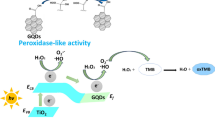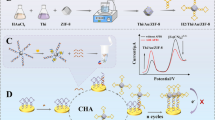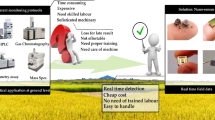Abstract
Decoration of graphene quantum dots (GQDs) on molybdenum disulfide (MoS2) nanosheets serves as an active electrode material which enhances the electrochemical performance of the analyte detection system. Herein, ionic surfactant cetyltrimethylammonium bromide (CTAB)-exfoliated MoS2 nanosheets decorated with GQD material are used to construct an electrochemical biosensor for aflatoxin B1 (AFB1) detection. An antibody of AFB1 (aAFB1) was immobilized on the electrophoretically deposited MoS2@GQDs film on the indium tin oxide (ITO)-coated glass surface using a crosslinker for the fabrication of the biosensor. The immunosensing study investigated by the electrochemical method revealed a signal response in the range of 0.1 to 3.0 ng/mL AFB1 concentration with a detection limit of 0.09 ng/mL. Also, electrochemical parameters such as diffusion coefficient and heterogeneous electron transfer (HET) were calculated and found to be 1.67 × 10−5 cm2/s and 2 × 10−5 cm/s, respectively. The effective conjugation of MoS2@GQDs that provides abundant exposed edge sites, large surface area, improved electrical conductivity, and electrocatalytic activity has led to an excellent biosensing performance with enhanced electrochemical parameters. Validation of the fabricated immunosensor was performed in a spiked maize sample, and a good percentage of recoveries within an acceptable range were obtained (80.2 to 98.3%).
Graphical abstract






Similar content being viewed by others
References
Moretti A, Logrieco AF, Susca A. Mycotoxins: an underhand food problem. Mycotoxigenic Fungi: Springer; 2017. p. 3–12.
Abbas HK, Accinelli C, Shier WT. Biological control of aflatoxin contamination in U.S. crops and the use of bioplastic formulations of Aspergillus flavus biocontrol strains to optimize application strategies. J Agric Food Chem. 2017;65(33):7081–7.
Neme K, Mohammed A. Mycotoxin occurrence in grains and the role of postharvest management as a mitigation strategies. A review. Food Control. 2017;78:412–25.
Guo W, Wu L, Fan K, Nie D, He W, Yang J, et al. Reduced graphene oxide-gold nanoparticle nanoframework as a highly selective separation material for aflatoxins. Sci Rep. 2017;7(1):14484.
Bhardwaj H, Pandey MK, Rajesh, Sumana G. Electrochemical aflatoxin B1 immunosensor based on the use of graphene quantum dots and gold nanoparticles. Microchim Acta. 2019;186(8):592.
Guan Z, Lian C-S, Hu S, Ni S, Li J, Duan W. Tunable structural, electronic, and optical properties of layered two-dimensional C2N and MoS2 van der Waals heterostructure as photovoltaic material. J Phys Chem C. 2017;121(6):3654–60.
Hoshide T, Zheng Y, Hou J, Wang Z, Li Q, Zhao Z, et al. Flexible lithium-ion fiber battery by the regular stacking of two-dimensional titanium oxide nanosheets hybridized with reduced graphene oxide. Nano Lett. 2017;17(6):3543–9.
Seh ZW, Fredrickson KD, Anasori B, Kibsgaard J, Strickler AL, Lukatskaya MR, et al. Two-dimensional molybdenum carbide (MXene) as an efficient electrocatalyst for hydrogen evolution. ACS Energy Lett. 2016;1(3):589–94.
Huang K-J, Liu Y-J, Wang H-B, Wang Y-Y, Liu Y-M. Sub-femtomolar DNA detection based on layered molybdenum disulfide/multi-walled carbon nanotube composites, Au nanoparticle and enzyme multiple signal amplification. Biosens Bioelectron. 2014;55:195–202.
Koppens FHL, Mueller T, Avouris P, Ferrari AC, Vitiello MS, Polini M. Photodetectors based on graphene, other two-dimensional materials and hybrid systems. Nat Nanotechnol. 2014;9:780.
Song Y, Luo Y, Zhu C, Li H, Du D, Lin Y. Recent advances in electrochemical biosensors based on graphene two-dimensional nanomaterials. Biosens Bioelectron. 2016;76:195–212.
Chen Y, Fan Z, Zhang Z, Niu W, Li C, Yang N, et al. Two-dimensional metal nanomaterials: synthesis, properties, and applications. Chem Rev. 2018;118(13):6409–55.
Su S, Sun H, Cao W, Chao J, Peng H, Zuo X, et al. Dual-target electrochemical biosensing based on DNA structural switching on gold nanoparticle-decorated MoS2 nanosheets. ACS Appl Mater Interfaces. 2016;8(11):6826–33.
Huang J, He Y, Jin J, Li Y, Dong Z, Li R. A novel glucose sensor based on MoS2 nanosheet functionalized with Ni nanoparticles. Electrochim Acta. 2014;136:41–6.
Ataca C, Ciraci S. Functionalization of single-layer MoS2 honeycomb structures. J Phys Chem C. 2011;115(27):13303–11.
Vilian AE, Dinesh B, Kang S-M, Krishnan UM, Huh YS, Han Y-K. Recent advances in molybdenum disulfide-based electrode materials for electroanalytical applications. Microchim Acta. 2019;186(3):203.
Gupta A, Arunachalam V, Vasudevan S. Water dispersible, positively and negatively charged MoS2 nanosheets: surface chemistry and the role of surfactant binding. J Phys Chem Lett. 2015;6(4):739–44.
McAteer D, Gholamvand Z, McEvoy N, Harvey A, O’Malley E, Duesberg GS, et al. Thickness dependence and percolation scaling of hydrogen production rate in MoS2 nanosheet and nanosheet–carbon nanotube composite catalytic electrodes. ACS Nano. 2016;10(1):672–83.
Li Z, Ye R, Feng R, Kang Y, Zhu X, Tour JM, et al. Graphene quantum dots doping of MoS2 monolayers. Adv Mater. 2015;27(35):5235–40.
Zhang Z, Zhang J, Chen N, Qu L. Graphene quantum dots: an emerging material for energy-related applications and beyond. Energy Environ Sci. 2012;5(10):8869–90.
Yan X, Song Y, Zhu C, Song J, Du D, Su X, et al. Graphene quantum dot–MnO2 nanosheet based optical sensing platform: a sensitive fluorescence “Turn Off–On” nanosensor for glutathione detection and intracellular imaging. ACS Appl Mater Interfaces. 2016;8(34):21990–6.
Lukowski MA, Daniel AS, Meng F, Forticaux A, Li L, Jin S. Enhanced hydrogen evolution catalysis from chemically exfoliated metallic MoS2 nanosheets. J Am Chem Soc. 2013;135(28):10274–7.
Zhang S-L, Yue H, Liang X, Yang W-C. Liquid-phase Co-exfoliated graphene/MoS2 nanocomposite for methanol gas sensing. J Nanosci Nanotechnol. 2015;15(10):8004–9.
Coleman JN, Lotya M, O’Neill A, Bergin SD, King PJ, Khan U, et al. Two-dimensional nanosheets produced by liquid exfoliation of layered materials. Science. 2011;331(6017):568.
Bhardwaj H, Singh C, Kotnala R, Sumana G. Graphene quantum dots-based nano-biointerface platform for food toxin detection. Anal Bioanal Chem. 2018;410(28):7313–23.
Bhardwaj H, Singh C, Pandey M, Sumana G. Star shaped zinc sulphide quantum dots self-assembled monolayers: preparation and applications in food toxin detection. Sensors Actuators B Chem. 2016;231:624–33.
Bhardwaj H, Sumana G, Marquette CA. A label-free ultrasensitive microfluidic surface plasmon resonance biosensor for aflatoxin B1 detection using nanoparticles integrated gold chip. Food Chem. 2020;307:125530.
Park JH, Kim Y-P, Kim I-H, Ko S. Rapid detection of aflatoxin B1 by a bifunctional protein crosslinker-based surface plasmon resonance biosensor. Food Control. 2014;36(1):183–90.
Tralamazza SM, Bemvenuti RH, Zorzete P, de Souza GF, Corrêa B. Fungal diversity and natural occurrence of deoxynivalenol and zearalenone in freshly harvested wheat grains from Brazil. Food Chem. 2016;196:445–50.
Cole RJ, Cox RH. Handbook of toxic fungal metabolites. Academic Press; 1981.
Zhao XS, Kong WJ, Wang S, Wei JH, Yang MH. Simultaneous analysis of multiple mycotoxins in Alpinia oxyphylla by UPLC-MS/MS. World Mycotoxin J. 2017;10(1):41–51.
Wang D, Song L, Zhou K, Yu X, Hu Y, Wang J. Anomalous nano-barrier effects of ultrathin molybdenum disulfide nanosheets for improving the flame retardance of polymer nanocomposites. J Mater Chem A. 2015;3(27):14307–17.
Mukherjee S, Maiti R, Midya A, Das S, Ray SK. Tunable direct bandgap optical transitions in MoS2 nanocrystals for photonic devices. ACS Photonics. 2015;2(6):760–8.
Li Y, Wang J, Tian X, Ma L, Dai C, Yang C, et al. Carbon doped molybdenum disulfide nanosheets stabilized on graphene for the hydrogen evolution reaction with high electrocatalytic ability. Nanoscale. 2016;8(3):1676–83.
Zhou K, Liu J, Zeng W, Hu Y, Gui Z. In situ synthesis, morphology, and fundamental properties of polymer/MoS2 nanocomposites. Compos Sci Technol. 2015;107:120–8.
Wang C, Jin J, Sun Y, Yao J, Zhao G, Liu Y. In-situ synthesis and ultrasound enhanced adsorption properties of MoS2/graphene quantum dot nanocomposite. Chem Eng J. 2017;327:774–82.
Ali MA, Kamil Reza K, Srivastava S, Agrawal VV, John R, Malhotra BD. Lipid–lipid interactions in aminated reduced graphene oxide interface for biosensing application. Langmuir. 2014;30(14):4192–201.
Yan Y, Ge X, Liu Z, Wang J-Y, Lee J-M, Wang X. Facile synthesis of low crystalline MoS 2 nanosheet-coated CNTs for enhanced hydrogen evolution reaction. Nanoscale. 2013;5(17):7768–71.
Liu Y-M, Zhou M, Liu Y-Y, Huang K-J, Cao J-T, Zhang J-J, et al. A novel sandwich electrochemiluminescence aptasensor based on molybdenum disulfide nanosheet–graphene composites and Au nanoparticles for signal amplification. Anal Methods. 2014;6(12):4152–7.
Hu SW, Yang LW, Tian Y, Wei XL, Ding JW, Zhong JX, et al. Non-covalent doping of graphitic carbon nitride with ultrathin graphene oxide and molybdenum disulfide nanosheets: an effective binary heterojunction photocatalyst under visible light irradiation. J Colloid Interface Sci. 2014;431:42–9.
Ohno R, Ohnuki H, Wang H, Yokoyama T, Endo H, Tsuya D, et al. Electrochemical impedance spectroscopy biosensor with interdigitated electrode for detection of human immunoglobulin A. Biosens Bioelectron. 2013;40(1):422–6.
Veth C, Dragicevic D, Merten C. Thermal characterizations of a large-format lithium ion cell focused on high current discharges. J Power Sources. 2014;267:760–9.
Guo T, Wang L, Sun S, Wang Y, Chen X, Zhang K, et al. Layered MoS2@ graphene functionalized with nitrogen-doped graphene quantum dots as an enhanced electrochemical hydrogen evolution catalyst. Chin Chem Lett. 2019;30(6):1253–60.
Guo B, Yu K, Li H, Qi R, Zhang Y, Song H, et al. Coral-shaped MoS2 decorated with graphene quantum dots performing as a highly active electrocatalyst for hydrogen evolution reaction. ACS Appl Mater Interfaces. 2017;9(4):3653–60.
Song D, Wang Y, Lu X, Gao Y, Li Y, Gao F. Ag nanoparticles-decorated nitrogen-fluorine co-doped monolayer MoS2 nanosheet for highly sensitive electrochemical sensing of organophosphorus pesticides. Sensors Actuators B Chem. 2018;267:5–13.
Vasilescu I, Eremia SAV, Kusko M, Radoi A, Vasile E, Radu G-L. Molybdenum disulphide and graphene quantum dots as electrode modifiers for laccase biosensor. Biosens Bioelectron. 2016;75:232–7.
Balasubramanian P, Balamurugan TST, Chen S-M, Chen T-W, Lin P-H. A novel, efficient electrochemical sensor for the detection of isoniazid based on the B/N doped mesoporous carbon modified electrode. Sensors Actuators B Chem. 2019;283:613–20.
Chandra S, Gäbler C, Schliebe C, Lang H, Bahadur D. Fabrication of a label-free electrochemical immunosensor using a redox active ferrocenyl dendrimer. New J Chem. 2016;40(11):9046–53.
Wang Z, Chen T, Chen W, Chang K, Ma L, Huang G, et al. CTAB-assisted synthesis of single-layer MoS 2–graphene composites as anode materials of Li-ion batteries. J Mater Chem A. 2013;1(6):2202–10.
Srivastava S, Ali MA, Umrao S, Parashar UK, Srivastava A, Sumana G, et al. Graphene oxide-based biosensor for food toxin detection. Appl Biochem Biotechnol. 2014;174(3):960–70.
Srivastava S, Kumar V, Ali MA, Solanki PR, Srivastava A, Sumana G, et al. Electrophoretically deposited reduced graphene oxide platform for food toxin detection. Nanoscale. 2013;5(7):3043–51.
Kalita P, Singh J, Kumar Singh M, Solanki PR, Sumana G, Malhotra B. Ring like self assembled Ni nanoparticles based biosensor for food toxin detection. Appl Phys Lett. 2012;100(9):093702.
Yagati A, Chavan S, Baek C, Lee M-H, Min J. Label-free impedance sensing of aflatoxin B1 with polyaniline nanofibers/Au nanoparticle electrode array. Sensors. 2018;18(5):1320.
Foguel M, Furlan Giordano G, de Sylos C, Carlos I, Pupim Ferreira A, Benedetti A, et al. A low-cost label-free AFB1 impedimetric immunosensor based on functionalized CD-trodes. Chemosensors. 2016;4(3):17.
Li Z, Ye Z, Fu Y, Xiong Y, Li Y. A portable electrochemical immunosensor for rapid detection of trace aflatoxin B 1 in rice. Anal Methods. 2016;8(3):548–53.
Masoomi L, Sadeghi O, Banitaba MH, Shahrjerdi A, Davarani SSH. A non-enzymatic nanomagnetic electro-immunosensor for determination of aflatoxin B1 as a model antigen. Sensors Actuators B Chem. 2013;177:1122–7.
Acknowledgments
We thank Director, CSIR-National Physical Laboratory, New Delhi, India, for providing facilities. We sincerely thank Prof. B.D. Malhotra and Dr. R.K. Kotnala for interesting discussions. H.B. thanks Dr. Chandan Singh, Dr. Shipra Solanki, and Dr. Razi Ahmad for suggestions.
Author information
Authors and Affiliations
Corresponding author
Ethics declarations
Conflict of interest
The authors declare that they have no conflicts of interest.
Ethical approval
This article does not contain any studies related to human participants or animal performed by any authors.
Additional information
Publisher’s note
Springer Nature remains neutral with regard to jurisdictional claims in published maps and institutional affiliations.
Electronic supplementary material
ESM 1
(PDF 951 kb)
Rights and permissions
About this article
Cite this article
Bhardwaj, H., Marquette, C.A., Dutta, P. et al. Integrated graphene quantum dot decorated functionalized nanosheet biosensor for mycotoxin detection. Anal Bioanal Chem 412, 7029–7041 (2020). https://doi.org/10.1007/s00216-020-02840-0
Received:
Revised:
Accepted:
Published:
Issue Date:
DOI: https://doi.org/10.1007/s00216-020-02840-0




